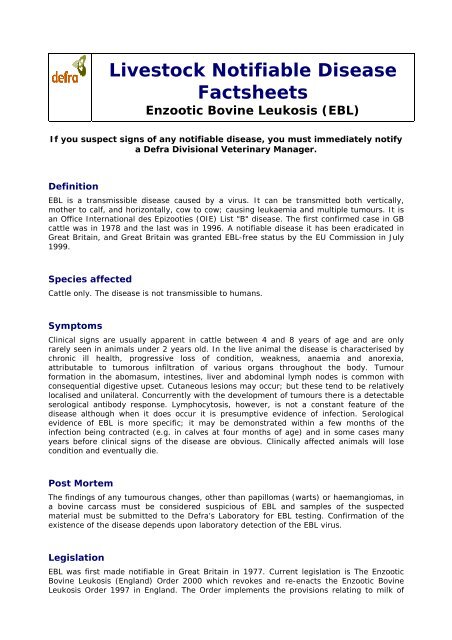Disease factsheet: Enzootic Bovine Leukosis (EBL) - ADLib
Disease factsheet: Enzootic Bovine Leukosis (EBL) - ADLib
Disease factsheet: Enzootic Bovine Leukosis (EBL) - ADLib
Create successful ePaper yourself
Turn your PDF publications into a flip-book with our unique Google optimized e-Paper software.
Livestock Notifiable <strong>Disease</strong><br />
Factsheets<br />
<strong>Enzootic</strong> <strong>Bovine</strong> <strong>Leukosis</strong> (<strong>EBL</strong>)<br />
If you suspect signs of any notifiable disease, you must immediately notify<br />
a Defra Divisional Veterinary Manager.<br />
Definition<br />
<strong>EBL</strong> is a transmissible disease caused by a virus. It can be transmitted both vertically,<br />
mother to calf, and horizontally, cow to cow; causing leukaemia and multiple tumours. It is<br />
an Office International des Epizooties (OIE) List "B" disease. The first confirmed case in GB<br />
cattle was in 1978 and the last was in 1996. A notifiable disease it has been eradicated in<br />
Great Britain, and Great Britain was granted <strong>EBL</strong>-free status by the EU Commission in July<br />
1999.<br />
Species affected<br />
Cattle only. The disease is not transmissible to humans.<br />
Symptoms<br />
Clinical signs are usually apparent in cattle between 4 and 8 years of age and are only<br />
rarely seen in animals under 2 years old. In the live animal the disease is characterised by<br />
chronic ill health, progressive loss of condition, weakness, anaemia and anorexia,<br />
attributable to tumorous infiltration of various organs throughout the body. Tumour<br />
formation in the abomasum, intestines, liver and abdominal lymph nodes is common with<br />
consequential digestive upset. Cutaneous lesions may occur; but these tend to be relatively<br />
localised and unilateral. Concurrently with the development of tumours there is a detectable<br />
serological antibody response. Lymphocytosis, however, is not a constant feature of the<br />
disease although when it does occur it is presumptive evidence of infection. Serological<br />
evidence of <strong>EBL</strong> is more specific; it may be demonstrated within a few months of the<br />
infection being contracted (e.g. in calves at four months of age) and in some cases many<br />
years before clinical signs of the disease are obvious. Clinically affected animals will lose<br />
condition and eventually die.<br />
Post Mortem<br />
The findings of any tumourous changes, other than papillomas (warts) or haemangiomas, in<br />
a bovine carcass must be considered suspicious of <strong>EBL</strong> and samples of the suspected<br />
material must be submitted to the Defra’s Laboratory for <strong>EBL</strong> testing. Confirmation of the<br />
existence of the disease depends upon laboratory detection of the <strong>EBL</strong> virus.<br />
Legislation<br />
<strong>EBL</strong> was first made notifiable in Great Britain in 1977. Current legislation is The <strong>Enzootic</strong><br />
<strong>Bovine</strong> <strong>Leukosis</strong> (England) Order 2000 which revokes and re-enacts the <strong>Enzootic</strong> <strong>Bovine</strong><br />
<strong>Leukosis</strong> Order 1997 in England. The Order implements the provisions relating to milk of
Council Directive 64/432/EEC as amended on health problems affecting intra-Community<br />
trade in bovine animals and swine, and Council Directive 77/391/EEC as amended<br />
introducing Community measures for the eradication of brucellosis, tuberculosis and<br />
leukosis. These Directives require the operation of a monitoring and testing programme in<br />
order to maintain officially enzootic bovine leukosis-free status for Great Britain under<br />
Council Directive 64/432/EEC.<br />
The principal changes made by this Order relate to the arrangements for testing milk for<br />
evidence of enzootic bovine leukosis and the removal of the list of approved laboratories<br />
that were contained in Schedule 1 to the 1997 Order. Notice must be given to the Divisional<br />
Veterinary Manager if any animal, carcase or laboratory sample is suspected of being<br />
infected with enzootic bovine leukosis. Article 6 sets out the duties of purchasers of milk in<br />
England in any form for resale to ensure that milk is sent for testing to an approved<br />
laboratory. The person in charge of an approved laboratory must notify the Secretary of<br />
State of any positive test results within 24 hours and negative test results within one<br />
month, and also maintain records of all tests carried out for a period of one year from the<br />
date of the test.<br />
Failure to comply with any of the provisions of the Order is an offence under the Animal<br />
Health Act 1981.<br />
Treatment<br />
Treatment for <strong>EBL</strong> of cattle is not permitted. All infected cattle and contacts which have<br />
been exposed to infection must be slaughtered.<br />
Information current of June 16, 2005


